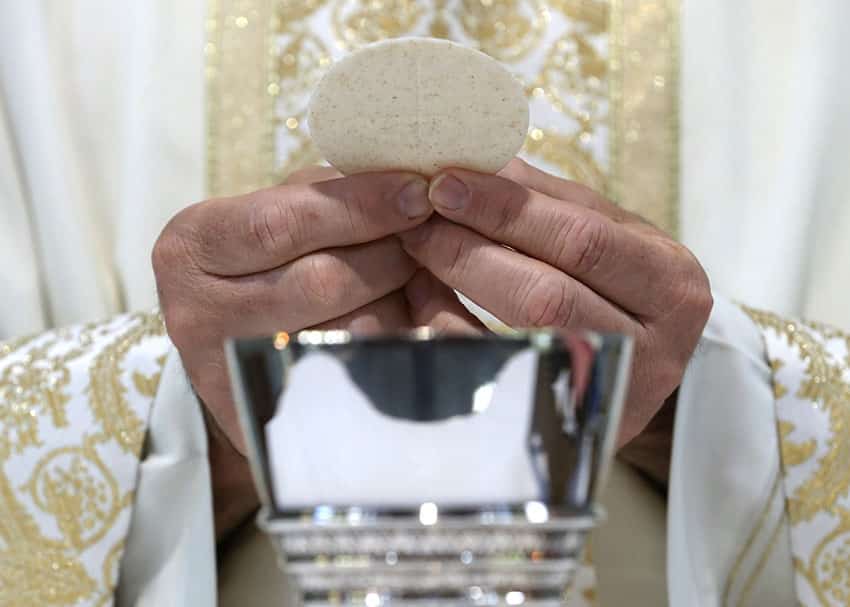
Dear father, I heard recently that there has been a Eucharistic miracle in Honduras. Can you tell me something about it, and whether the findings were in any way similar to those of other Eucharistic miracles?
According to EWTN News, Walter Guillén Soto, the bishop of the diocese of Gracias in Honduras, has recognised a Eucharistic miracle that had taken place in his diocese a year before. The miracle occurred in the tiny village of El Espinal, just outside San Juan, in the department of Intibucá.
Late in the afternoon of 9 June 2022, when the church was celebrating the feast of Jesus Christ, Eternal High Priest on the Thursday after Pentecost, José Elmer Benítez Machado, an extraordinary minister of Communion, arrived in the chapel of El Espinal to conduct a Liturgy of the Word and distribute Communion to those present.
Some 60 farming families live in the mountainous region around El Espinal and some 15 of them attend the Liturgy of the Word each Thursday. The service is conducted by a lay minister since there is no priest in the village.
When it was time to distribute Communion, Benitez opened the tabernacle and noticed that the corporal, a sacred linen cloth, which was placed under and over the ciborium containing the hosts, appeared to have large blood stains on it.
Despite his consternation, he went ahead and gave Communion to those present. Afterwards, at the time of the announcements, he asked those present if they had seen any water leaking into the church or if they knew of anyone who had entered the chapel beforehand. No one said they had. He then told them about the blood stains, and the people asked to see the corporal, which he showed them.
The next day two priests, Missionaries of the Sacred Heart of Jesus based in San Juan, went to El Espinal to verify what they had been told. One of them, Fr Marvin Sotelo, put the corporal in a plastic bag with a hermetic seal and took it to his presbytery, handing it over to Bishop Guillén Soto two days later. The bishop was naturally sceptical and he put the corporal in his personal chapel while he decided what to do.
Some three months later he asked for scientific tests to be carried out on the corporal. The tests were done at the DISA Test toxicological centre in Tegucigalpa, by a team led by Dr Héctor Díaz del Valle, who holds a doctorate in chemistry and pharmacy.
The tests began at the end of October 2022 with the participation of an outside forensic expert and Dr Claudia Coca, a professor of chemistry and pharmacy at the National Autonomous University of Honduras. She had previously been head of the laboratory of the Police Directorate of Investigations.
The tests revealed that the stains were of human blood of type AB with a positive Rh factor. It is the same type as in the Eucharistic miracles of Tixtla in Mexico, the eighth-century miracle of Lanciano in Italy and the Shroud of Turin. According to the World Population Review portal in Honduras, less than 2.5 per cent of the population in that country has that blood type.
The tests also ruled out the possibility that the pattern of the blood stains could have been made artificially. Dr del Valle was surprised too that the corporal had been in contact with air and humidity and yet it did not show signs of deterioration or fungus.
After receiving the scientific report, Bishop Guillén Soto said he did not doubt the credibility of the test results.
“I think that this extraordinary, visible, tangible, perceptible, verifiable sign of this manifestation of the blood of the Lord in an obscure community in the midst of the most extreme rurality of our agricultural environment says a lot at this time … God loves the marginal, the hidden, the simple. In an obscure village, without any social relevance, far from the urban area, the Lord chooses to manifest himself,” he told EWTN.
Fr Sotelo said he trusts that with the Eucharistic miracle, the “community will grow in love for the Eucharist, in adoration of the Blessed Sacrament, and that it will grow in fraternity.”
The scientific evidence and the notarised oaths of those involved have now been sent to the Vatican for further investigation.
